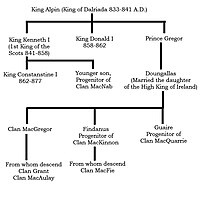| Clan Macfie | |||
|---|---|---|---|
 Crest: A demi lion rampant Proper | |||
| Motto | Pro rege (For the King) | ||
| Profile | |||
| Region | Highlands | ||
| District | Colonsay | ||
| Plant badge | Scots fir, oak or crowberry | ||
| Clan Macfie no longer has a chief, and is an armigerous clan | |||
| Historic seat | Dùn Eibhinn[1] | ||
| Last Chief | Malcolm Macfie of Colonsay | ||
| Died | 1623 [2] | ||
| Commander | Ian McPhee of Halifax.[3] | ||
| |||


Clan Macfie is a Highlands Scottish Clan.
Since 1981, the clan has been officially registered with the Court of the Lord Lyon,[2] which is the heraldic authority of Scotland.
The clan is considered an armigerous clan because even though the clan is recognised by the Court of the Lord Lyon, it is currently without a chief recognised by the Lord Lyon King of Arms, the judge of the Court of the Lord Lyon.[4]
The official clan name Macfie is derived from the Common Gaelic Mac Dhuibhshíthe (modern Scottish Gaelic Scottish Gaelic: MacDhubhShìth.[dubious – discuss] This Gaelic patronymic name has been Anglicised into various forms, many of which are considered associated names of the clan. The clan has a long history with the islands of Colonsay and Oronsay in the Scottish Inner Hebrides,[5] and today many monuments to various lairds and churchmen of the clan are found on these islands.
The 19th century historian W. F. Skene named the clan as one of the seven clans of Siol Alpin—who according to Skene could all trace their ancestry back to Alpin, father of Cináed mac Ailpín.[5]
Little is known of the early history of the clan. However, is certain that the clan served under the Lords of the Isles—descendants of Somerled, who ruled the Hebrides from the 14th century to the late 16th century.[5] Following the forfeiture of the Lordship of the Isles in the late 15th century, the clan still attached itself to powerful Macdonalds. In the early 17th century the last chief of the clan was executed as Colonsay was lost to the control of a Macdonald. Without a chief of their own to control their home lands the clan was considered a leaderless "broken clan". From this point on the Macfies followed the Macdonalds of Islay, though a branch of the clan was dispersed to lands controlled by Clan Cameron.[6] In the early 19th century Ewen Macphee became a notorious outlaw, "revered and feared by locals and despised by the authorities".[7] Today the modern Clan Macfie is alive with nine associated clan societies located around the world.[2]
- ^ clanmacfieofamerica.com
- ^ a b c "Clan Macfie symbols and history". clanmacfie.co.uk. Retrieved 13 April 2009.
- ^ clanmacfie.co.uk
- ^ "Official Scottish Clans and Families". electricscotland.com. Retrieved 12 April 2008. See also "History of the Court of the Lord Lyon". Court of the Lord Lyon. Archived from the original on 2 August 2009. Retrieved 14 April 2008. See also "The search for clan chiefs". Court of the Lord Lyon. Archived from the original on 23 April 2008. Retrieved 14 April 2008.
- ^ a b c Cite error: The named reference
Skene-344was invoked but never defined (see the help page). - ^ Eyre-Todd 1969: 403–406.
- ^ Gilchrist, Jim (12 July 2003). "The last outlaw". The Scotsman. Retrieved 16 November 2007.